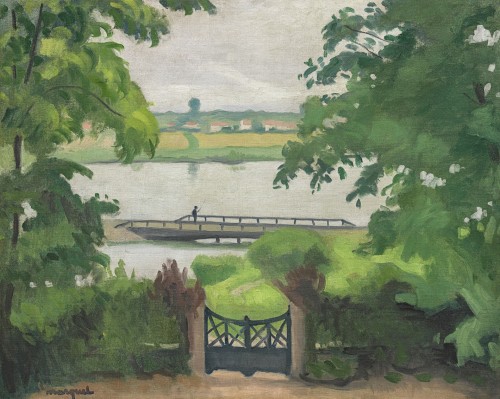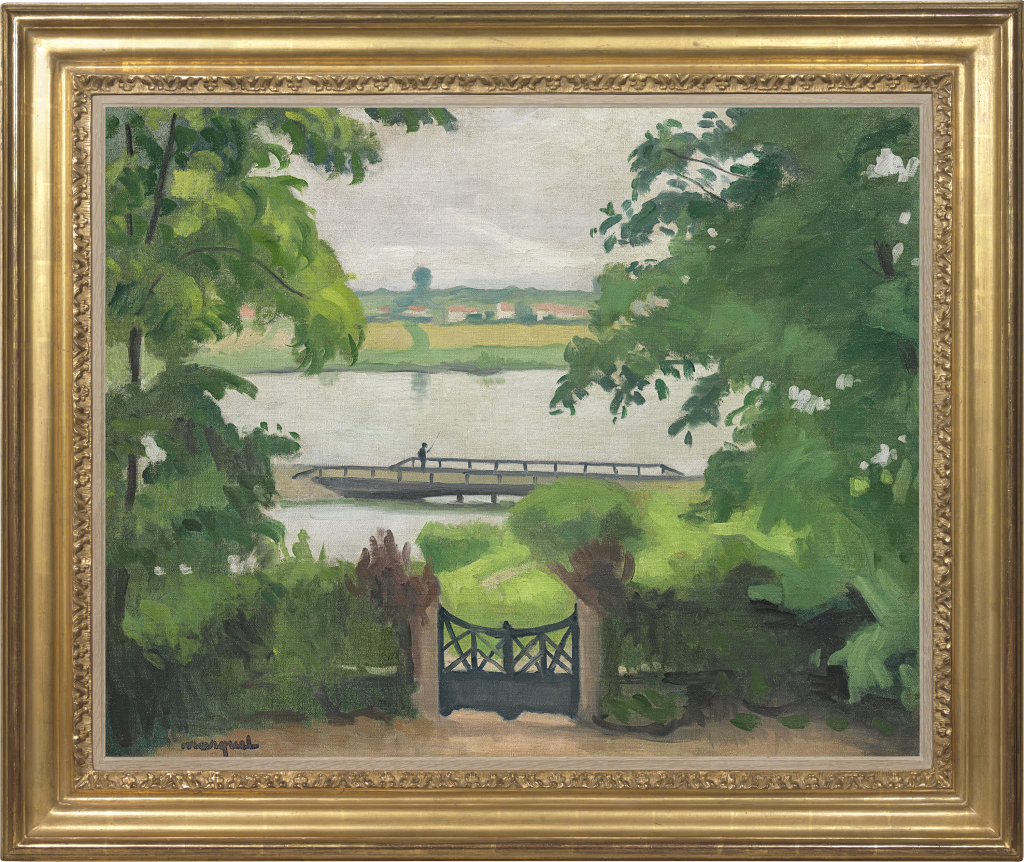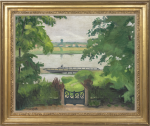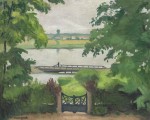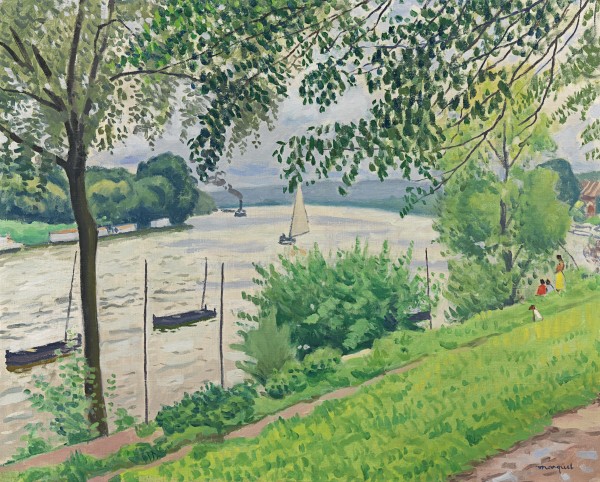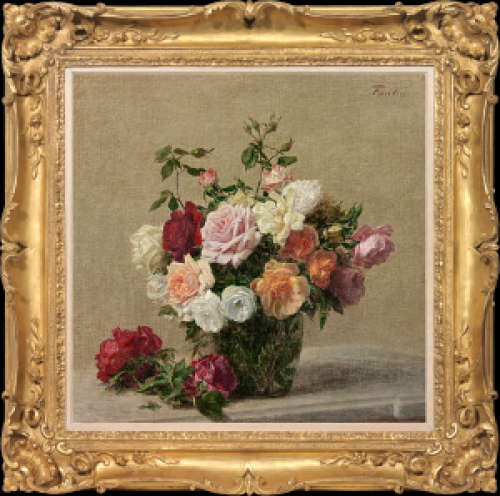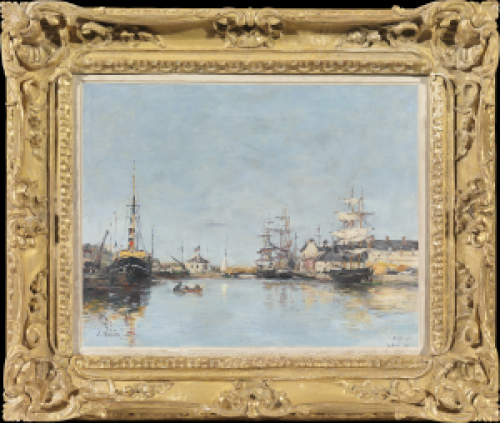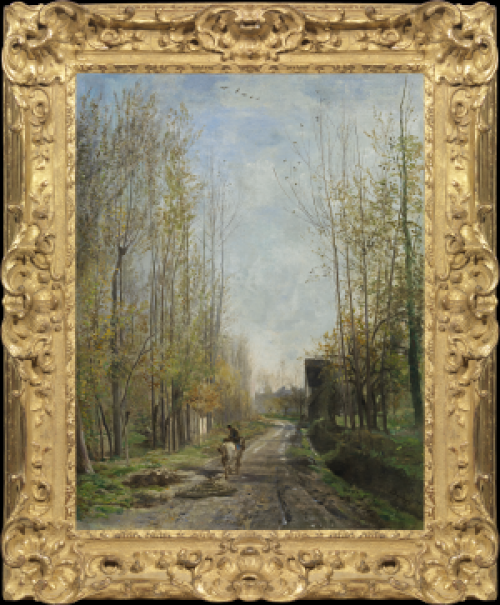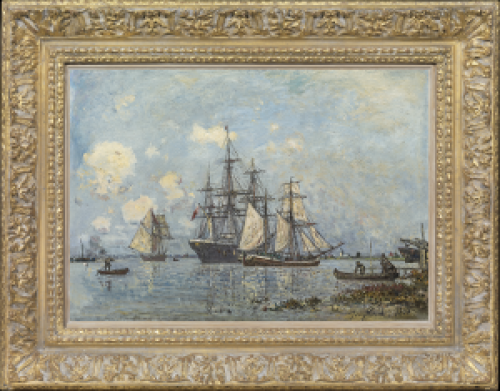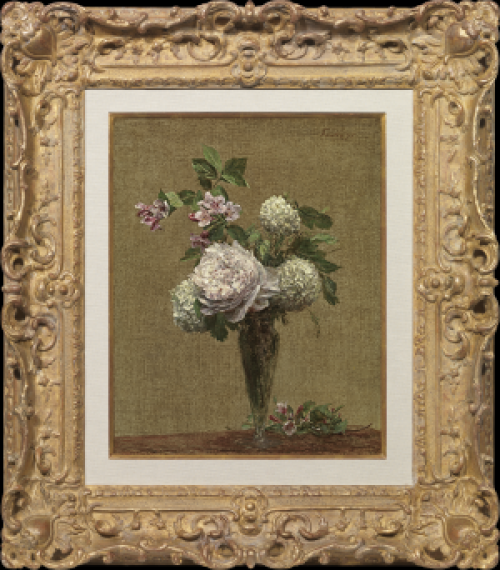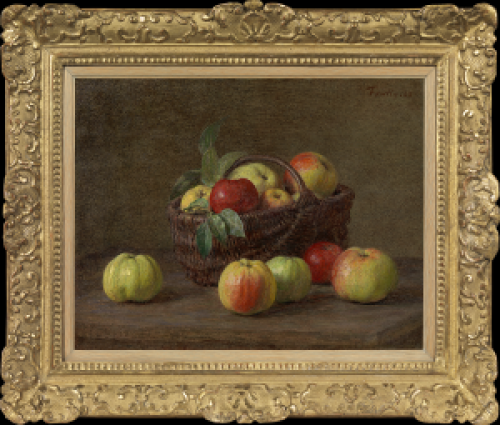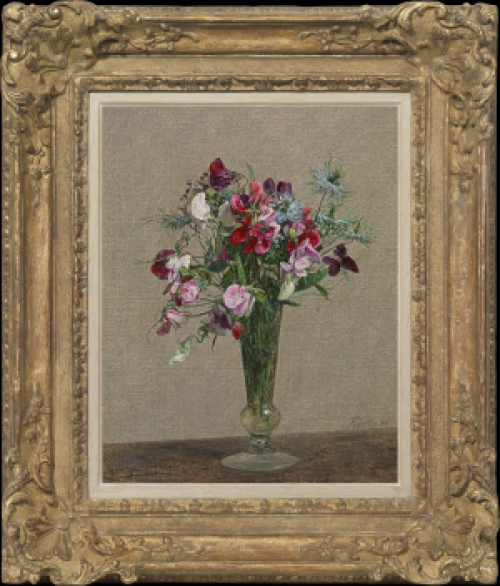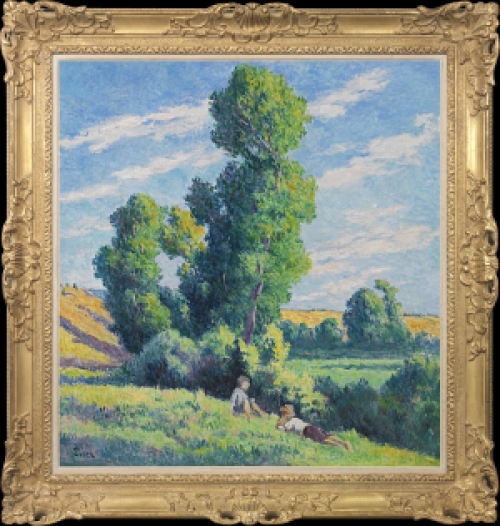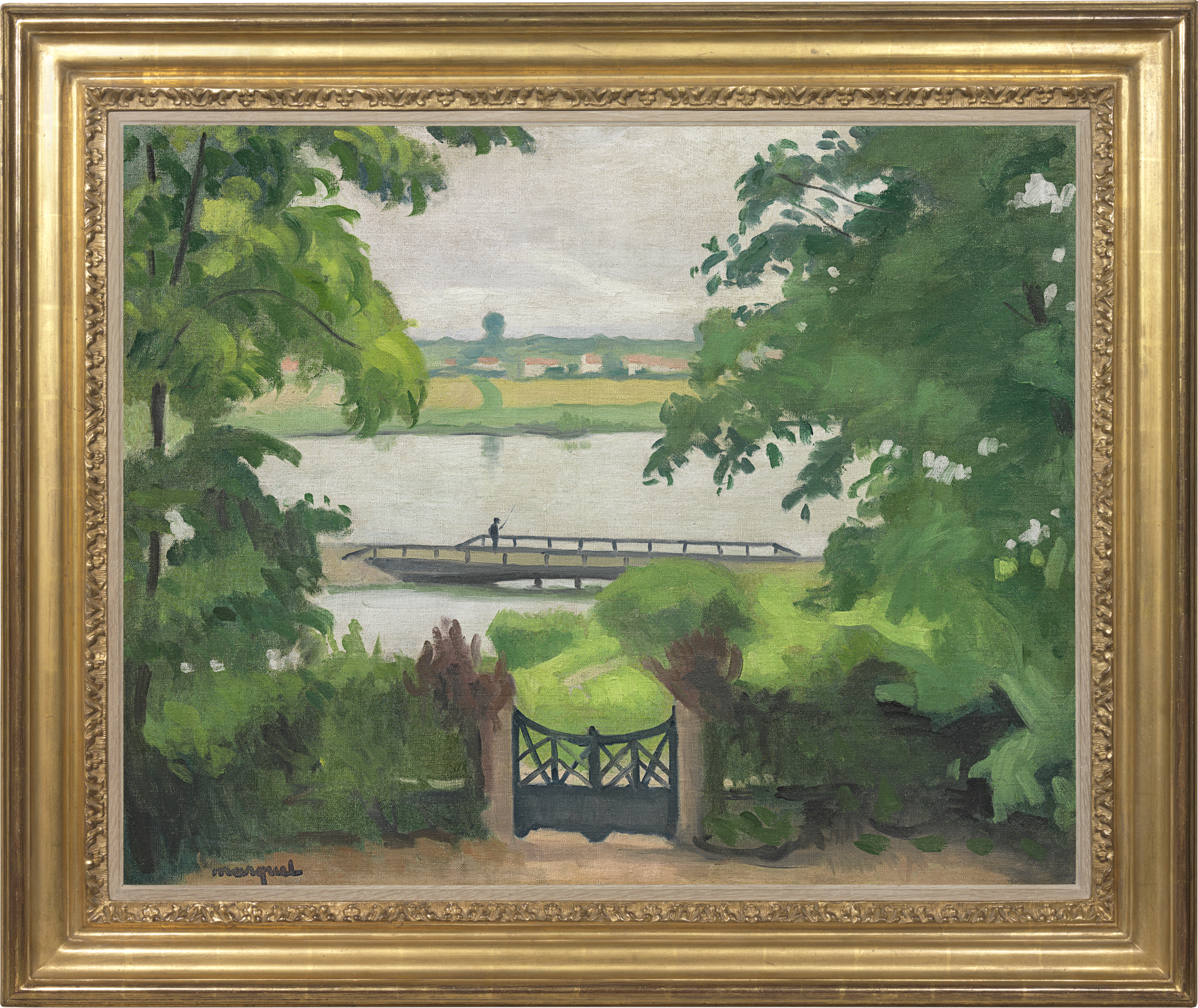ALBERT MARQUET
Bordeaux 1875 - 1947 Paris
Ref: CC 134
Samois, le portail vert
Signed lower left: marquet
Oil on canvas: 25 5/8 x 32 in / 65.1 x 81.3 cm
Frame size: 33 x 39 in / 83.8 x 99.1 cm
In a Louis XV style gilded composition frame
Painted in summer 1917
Provenance:
Private collection, Paris;
by descent to a private collection, Paris, in 2023
To be included in the forthcoming Digital Catalogue Raisonné of the work of Albert Marquet currently being prepared by the Wildenstein Plattner Institute, Inc., inv. no.24.03.14/21535
Albert Marquet lived on the banks of the Seine most of his life and became celebrated for his sensitive observation of Paris and its river. Fascinated by water, ports and coastline, he was also an inveterate traveller, visiting England, the USSR and North Africa, among other places, as well as exploring his native France.
As a young man in the studio of Gustave Moreau, Marquet forged friendships with Camoin, Rouault, Manguin and Matisse. They burst upon the Salon d’Automne in 1905 with vibrant colours and bold brushwork, leading a critic to dub them ‘Fauves’ (Wild Beasts). Marquet was closely associated with this group in the early years of the twentieth century.
By the time that this painting was made, in 1917, Marquet had forged a highly individual manner influenced by aspects of Impressionism, the work of Cézanne and the graceful economy of Japanese landscape prints. In August and September of that year he rented a villa in Samois-sur-Seine, north of Fontainebleau. He shared it with Yvonne Bazin, who for several years was his model and muse, the subject of many of his finest nudes. Despite the fact that the First World War was raging on the battlefields to the north-west, Marquet’s Samois paintings are permeated with the utmost serenity, almost in defiance of the outside world.
Taken from a high viewpoint, Samois, le portail vert looks down on the gates of the villa, which are framed by tall trees, giving a sense of enclosure and peace. Beyond, parallel with the gates, is a bridge with a solitary fisherman. Further off, beyond the silvery expanse of the calm Seine, a land of green and gold meadows rolls to distant buildings and the gentle hills that edge the Seine valley. Marquet is an exquisitely subtle colourist, capturing the moist, subdued light of northern France and the rich symphony of greens in this lush, high summer landscape. The elements of the composition are simplified and geometrically aligned, a receding band of horizontals balanced by the verticals of the foreground trees. Jacqueline Lafargue has written how Marquet ‘aborde le sujet dans une totale soumission, cherchant l’harmonie générale qui exprime le mieux le charactère essential du paysage’[1]. Marquet’s wife, Marcelle, summed up his philosophy in her memoir of the artist: ‘The dream of Marquet was to be the invisible but ever-present witness, a witness who missed nothing and who knew, without a system or apparent plan, how to disencumber things from that which weighed them down and deformed them, so as to arrive at their essential truth’[2].
Albert Marquet, Samois, l’île, 1917.
Musée Cantonal des Beaux-Arts de Lausanne.
Albert Marquet and Yvonne Bazin.
ALBERT MARQUET
Bordeaux 1875 - 1947 Paris
Albert Marquet was born in Bordeaux in 1875, the son of a railway employee, Joseph Marquet and his shop-owner wife Marguerite Deyres. A club foot made him sensitive and taciturn. Mother and son were close and Marguerite supported Albert’s artistic ambitions. He went to Paris to study at the Ecole des Arts Décoratifs at the age of fifteen. Six years later he joined the studio of Gustave Moreau, where he met and forged lasting friendships with Camoin, Rouault, Manguin and Matisse. During this period Marquet began to use the vibrant colours and bold brushwork that is characteristic of the Fauves, with whom he was closely associated. He exhibited at Berthe Weill and the Galerie Druet, Paris from 1902 and from 1903 at the Salon d’Automne.
After 1907 Marquet’s interest in Japonisme resulted in more sober works. He travelled extensively, frequently leaving his apartment on the banks of the Seine to visit England, Germany, Italy, the USSR, Scandinavia and North Africa, where he spent the years of the Second World War. Contrasting with the classical calm of Marquet’s landscapes are the realistic, erotic paintings and drawings of nudes that he produced in the first three decades of the twentieth century, including the Sapphic series of lithographs, the Académie des Dames (1920s). Marquet met his wife Marcelle Martinet, whom he married in 1923, on his first stay in Algiers in 1920.
The most profound influence on his work is that of the Impressionists and Post-Impressionists, notably Paul Cézanne. Like the Impressionists his favourite subjects were port scenes, beaches, quaysides, river views and coastal villages; he was particularly fascinated by the effect of light on water.
André Rouveyre, a fellow student in Gustave Moreau’s atelier, wrote: ‘Marquet reigns over the kingdom of light. The light that shines on the things of this world, of course, but also that which belongs to his pictures alone: a strangely regal quality that comes from his sensitivity and wisdom. Skies, hills, houses, streets all bathe in his subtle but intense lights’.
The work of Albert Marquet is represented in the Musée d’Orsay, Paris; the Centre Pompidou, Paris; the Musée des Beaux-Arts, La Rochelle; the Musée de Grenoble; the Hermitage, St Petersburg; Tate, London; the Metropolitan Museum of Art, New York; the Art Institute of Chicago and the National Gallery of Art, Washington DC.
[1] Quoted in Paris, Musée Carnavalet, Marquet: Vues de Paris et l’Ile de France, 2004, p.12.
[2] Quoted in Columbia, SC, Columbia Museum of Art, From Fauvism to Impressionism: Albert Marquet, 2001, p.7.

